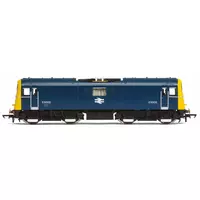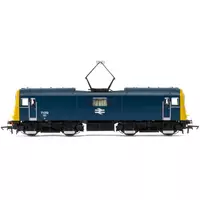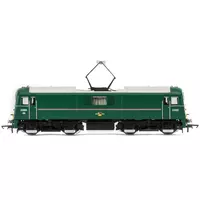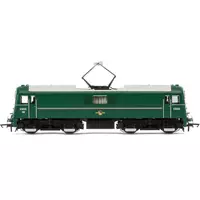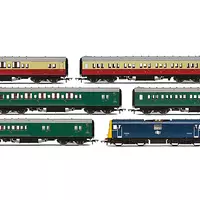Manufacturer catalogue image - please note that pre-release images may be CAD renders or CGI images rather than photographs
Prototype Eras
Era 4 (1948 to 1956) British Railways Early Crest
Era 5 (1957 to 1966) British Railways Late Crest
Era 6 (1967 to 1972) British Rail Blue (Pre-TOPS)
Manufacturer description
The early 1950s were a time of great plans and modern ideas, not least where the railways were concerned but still recovering from the financial effects of the Second World War. Many of these plans had to be implemented in a measured way.
Electric traction was seen by the newly nationalized British Rail to be the answer and so attention was focused on new routes in the Southern Region, where third rail electrification had been in place since 1923. Much of BR's Southern Region passenger traffic could be accommodated by the use of EMUs. But to cover the motive power requirement for 900 ton freight services, as well as the 'Night Ferry' and 'Golden Arrow' workings, a new electric locomotive was required. The design specification was based on the experience gained in the previous fifteen years through the operation of Bulleid's CC1 & CC2, Class 70 locomotives. By adopting the continental practice of reducing the weight without sacrificing tractive effort, a smaller engine could be built. This would result in a 750v DC, 77 ton, Bo-Bo locomotive, 24 of which were built by BR's Doncaster works between 1958 and 1960.
Numbered E5000 - E5023 as built (E5000 was subsequently renumbered to E5024 in December 1962), the type was classified by BR Southern Region as HA. To enable operation under the simple catenary wires erected in a number of Kentish yards at that time, a single pantograph was fitted centrally on the roof and a booster system was also fitted, avoiding the problem of 'gapping' across short breaks in the conductor rail. Ten of the class were converted to Class 74 engines in 1967/68, at a time when passenger duties for the Class 71s were being reduced and despite being moved onto extra freight workings. The type was under-utilized. In 1977, it was decided that the Class 33 and 73 Electro-diesels could take over the Class 71's duties and they were withdrawn from service.
Locomotive E5018 entered traffic in April 1960, being allocated to Stewarts Lane Shed initially. Having been transferred to Ashford Chart Leacon in August 1966, now December 1968, the locomotive was renumbered as E5003 following the conversion of ten of the class to Class 74 locomotives. Under the TOPS scheme, the locomotive became 71003 in December 1973, but just three years later in October 1976, it was moved to storage at Ashford, prior to being cut up at BREL Doncaster in November 1977.
Minimum curve Hornby 2nd radius+ / 438mm.
Catalogue listing
Model details
Interior lighting
Prototype information
* Class names often change over the lifespan of a locomotive, so this is not necessarily the class name used by the operator in the period modelled.
Supplier links are provided for your convenience and do not guarantee that the product is currently available. RailwayModels.uk is not a representative of these suppliers, but may receive a commission when purchases are made through links on this page.

